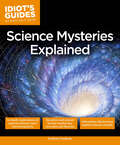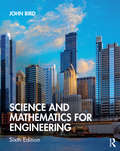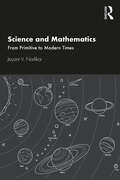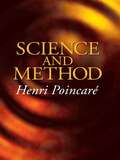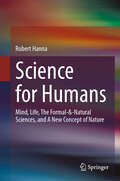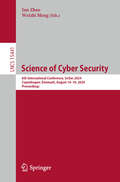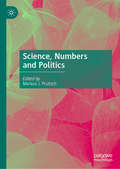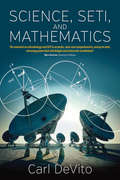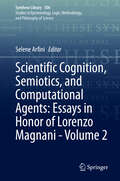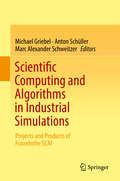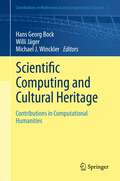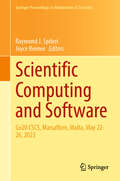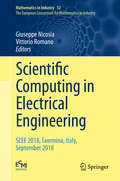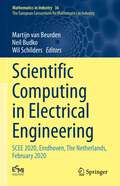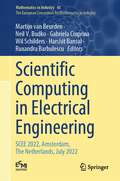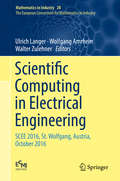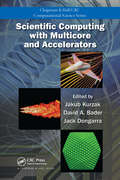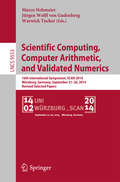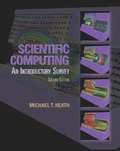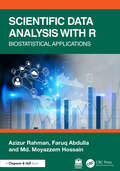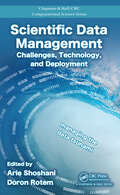- Table View
- List View
Science Mysteries Explained: In-Depth Explorations of Natural Science’s Most Fascinating Facts (Idiot's Guides)
by Anthony FordhamIdeal for the armchair science enthusiast, Idiot's Guides: Science Mysteries Explained takes a question/answer-based approach to teach readers a wide variety of topics in Earth Science, Life Science, Chemistry, Physics, and Cosmology. Using helpful full-color illustrations and expert information, this book features 130 fascinating questions and answers to satisfy any scientist wannabe.
Science and Mathematics for Engineering
by John BirdA practical introduction to the engineering science and mathematics required for engineering study and practice.Science and Mathematics for Engineering is an introductory textbook that assumes no prior background in engineering. This new edition covers the fundamental scientific knowledge that all trainee engineers must acquire in order to pass their examinations and has been brought fully in line with the compulsory science and mathematics units in the new engineering course specifications. A new chapter covers present and future ways of generating electricity, an important topic.John Bird focuses upon engineering examples, enabling students to develop a sound understanding of engineering systems in terms of the basic laws and principles. This book includes over 580 worked examples, 1300 further problems, 425 multiple choice questions (with answers), and contains sections covering the mathematics that students will require within their engineering studies, mechanical applications, electrical applications and engineering systems.This book is supported by a companion website of materials that can be found at www.routledge/cw/bird. This resource includes fully worked solutions of all the further problems for students to access, and the full solutions and marking schemes for the revision tests found within the book for instructor use. In addition, all 447 illustrations will be available for downloading by lecturers.
Science and Mathematics: From Primitive to Modern Times
by Jayant V. NarlikarThis book offers an engaging and comprehensive introduction to scientific theories and the evolution of science and mathematics through the centuries. It discusses the history of scientific thought and ideas and the intricate dynamic between new scientific discoveries, scientists, culture and societies. Through stories and historical accounts, the volume illustrates the human engagement and preoccupation with science and the interpretation of natural phenomena. It highlights key scientific breakthroughs from the ancient to later ages, giving us accounts of the work of ancient Greek and Indian mathematicians and astronomers, as well as of the work of modern scientists like Descartes, Newton, Planck, Mendel and many more. The author also discusses the vast advancements which have been made in the exploration of space, matter and genetics and their relevance in the advancement of the scientific tradition. He provides great insights into the process of scientific experimentation and the relationship between science and mathematics. He also shares amusing anecdotes of scientists and their interactions with the world around them. Detailed and accessible, this book will be of great interest to students and researchers of science, mathematics, the philosophy of science, science and technology studies and history. It will also be useful for general readers who are interested in the history of scientific discoveries and ideas.
Science and Method
by Henri PoincaréThis classic by the famous mathematician defines the basic methodology and psychology of scientific discovery, particularly regarding mathematics and mathematical physics. Drawing on examples from many fields, it explains how scientists analyze and choose their working facts, and it explores the nature of experimentation, theory, and the mind. 1914 edition.
Science for Humans: Mind, Life, The Formal-&-Natural Sciences, and A New Concept of Nature
by Robert HannaThis book presents and defends an original and paradigm-shifting conception of formal science, natural science, and the natural universe alike, that’s fully pro-science, but at the same time neither theological or God-centered, nor solipsistic or self-centered, nor communitarian or social-institution-centered, nor scientistic or science-valorizing, nor materialist/physicalist or reductive, nor—above all—mechanistic. It does this by presenting and defending what Robert Hanna calls the neo-organicist turn, including manifest realism and the three sub-parts of metaphysical organicism: liberal naturalism, mind-life continuity, and explanatory inversion, whereby mechanical systems are explained by grounding them in organic systems, and not the other way around. Or more briefly and simply put, the purpose of this book is to present and defend science for humans. As such, it will be highly interesting and profoundly relevant to graduate students and specialist researchers in philosophy and the formal-&-natural sciences.
Science in the City: Culturally Relevant STEM Education (Race And Education Ser.)
by Christopher Emdin Bryan A. BrownScience in the City examines how language and culture matter for effective science teaching. Author Bryan A. Brown argues that, given the realities of our multilingual and multicultural society, teachers must truly understand how issues of culture intersect with the fundamental principles of learning. This book links an exploration of contemporary research on urban science teaching to a more generative instructional approach in which students develop mastery by discussing science in culturally meaningful ways. <P><P> The book starts with a trenchant analysis of the “black tax,” a double standard at work in science language and classrooms that forces students of color to appropriate and express their science knowledge solely in ways that accord with the dominant culture and knowledge regime. Because we are in an interactive, multimedia world, the author also posits the necessity of applying what is known about best practices in science teaching to best practices in technology. <P><P> The book then turns to instruction, illustrating how science education can flourish if it is connected to students’ backgrounds, identities, language, and culture. In this empowered—and inclusive—form of science classroom, the role of narrative is key: educators use stories and anecdotes to induct students into the realm of scientific thinking; introduce big ideas in easy, familiar terms; and prioritize explanation over mastery of symbolic systems. The result is a classroom that showcases how the use of more familiar, culturally relevant modes of communication can pave the way for improved science learning.
Science of Cyber Security: 6th International Conference, SciSec 2024, Copenhagen, Denmark, August 14–16, 2024, Proceedings (Lecture Notes in Computer Science #15441)
by Jun Zhao Weizhi MengThis book constitutes the refereed proceedings of the 6th International Conference on Science of Cyber Security, SciSec 2024, held in Copenhagen, Denmark, during August 14–16, 2024. The 25 full papers presented here were carefully selected and reviewed from 79 submissions. These papers focus on the recent research, trends and challenges in the emerging field of Cyber Security.
Science, Numbers and Politics
by Markus J. PrutschThis study explores the dynamic relationship between science, numbers and politics. What can scientific evidence realistically do in and for politics? The volume contributes to that debate by focusing on the role of “numbers” as a means by which knowledge is expressed and through which that knowledge can be transferred into the political realm. Based on the assumption that numbers are constantly being actively created, translated, and used, and that they need to be interpreted in their respective and particular contexts, it examines how numbers and quantifications are made ‘politically workable’, examining their production, their transition into the sphere of politics and their eventual use therein. Key questions that are addressed include: In what ways does scientific evidence affect political decision-making in the contemporary world? How and why did quantification come to play such an important role within democratic politics? What kind of work do scientific evidence and numbers do politically?
Science, Seti, and Mathematics
by Carl L. DeVitoMathematics is as much a part of our humanity as music and art. And it is our mathematics that might be understandable, even familiar, to a distant race and might provide the basis for mutual communication. This book discusses, in a conversational way, the role of mathematics in the search for extraterrestrial intelligence. The author explores the science behind that search, its history, and the many questions associated with it, including those regarding the nature of language and the philosophical/psychological motivation behind this search.
Scientific Cognition, Semiotics, and Computational Agents: Essays in Honor of Lorenzo Magnani - Volume 2 (Synthese Library #506)
by Selene ArfiniThis book, the second of two volumes, focuses on scientific cognition, computationalism, and scholars' reception of what Lorenzo Magnani named "eco-cognitive" views on the mind. The authors of these chapters address complex questions, which regard, in part, Magnani’s contributions in the field of model-based science, the role of inferential models in mathematics, the transformations and possible applicability of Charles Sanders Peirce’s and Immanuel Kant’s concepts and insight into current understanding of scientific progress, and the still unsolved questions regarding the methodological steps that take researchers to scientific discoveries. Some contributions also address the problematic understanding of artificial agents as "intelligent," how cognition can be discussed within the limits of computationalism, and how the eco-cognitive perspective on the mind also affects the conception of scientific reasoning and socially constructed phenomena. The book is of great interest to those interested in epistemology, philosophy of science, mathematical logic and AI.
Scientific Computing and Algorithms in Industrial Simulations
by Michael Griebel Marc Alexander Schweitzer Anton SchüllerThe contributions gathered here provide an overview of current research projects and selected software products of the Fraunhofer Institute for Algorithms and Scientific Computing SCAI. They show the wide range of challenges that scientific computing currently faces, the solutions it offers, and its important role in developing applications for industry. Given the exciting field of applied collaborative research and development it discusses, the book will appeal to scientists, practitioners, and students alike. The Fraunhofer Institute for Algorithms and Scientific Computing SCAI combines excellent research and application-oriented development to provide added value for our partners. SCAI develops numerical techniques, parallel algorithms and specialized software tools to support and optimize industrial simulations. Moreover, it implements custom software solutions for production and logistics, and offers calculations on high-performance computers. Its services and products are based on state-of-the-art methods from applied mathematics and information technology.
Scientific Computing and Cultural Heritage
by Willi Jäger Hans Georg Bock Michael J. WincklerThe sheer computing power of modern information technology is changing the face of research not just in science, technology and mathematics, but in humanities and cultural studies too. Recent decades have seen a major shift both in attitudes and deployment of computers, which are now vital and highly effective tools in disciplines where they were once viewed as elaborate typewriters. This revealing volume details the vast array of computing applications that researchers in the humanities now have recourse to, including the dissemination of scholarly information through virtual 'co-laboratories', data retrieval, and the modeling of complex processes that contribute to our natural and cultural heritage. One key area covered in this book is the versatility of computers in presenting images and graphics, which is transforming the analysis of data sets and archaeological reconstructions alike. The papers published here are grouped into three broad categories that cover mathematical and computational methods, research developments in information systems, and a detailed portrayal of ongoing work on documenting, restoring and presenting cultural monuments including the temples in Pompeii and the Banteay Chhmar temples of the Angkorian period in present-day Cambodia. Originally presented at a research workshop in Heidelberg, Germany, they reflect the rapidly developing identity of computational humanities as an interdisciplinary field in its own right, as well as demonstrating the breadth of perspectives in this young and vibrant research area.
Scientific Computing and Software: Go20 CSCS, Marsalforn, Malta, May 22-26, 2023 (Springer Proceedings in Mathematics & Statistics #495)
by Raymond J. Spiteri Joyce ReimerThese proceedings present a curated collection of innovative approaches to tackling challenging problems in applied mathematics. These problems, often marked by instability, inaccuracy, and high computational cost, remain at the forefront of mathematical research due to their difficulty. Addressing this demand, the contributions in this volume offer robust numerical methods designed to improve the accuracy and efficiency of their solutions. The book originates from the Go20 Conference 2023, where established experts and emerging researchers explored cutting-edge methodologies. The discussions captured here situate new advancements within a broader historical and theoretical context, providing a well-rounded perspective on these pressing mathematical challenges. Topics covered include: Ordinary Differential Equations (ODEs) with singularities Multi-dimensional and multi-rate systems of Partial Differential Equations (PDEs) High-index Differential-Algebraic Equations (DAEs) Inverse and optimal control problems This collection is a valuable resource for researchers and practitioners working on these or related topics. It offers comprehensive analyses and practical insights that bridge foundational principles with modern numerical innovations.
Scientific Computing in Electrical Engineering: SCEE 2018, Taormina, Italy, September 2018 (Mathematics in Industry #32)
by Giuseppe Nicosia Vittorio RomanoThis collection of selected papers presented at the 12th International Conference on Scientific Computing in Electrical Engineering, SCEE 2018, held in Taormina, Sicily, Italy, in September 2018, showcases the state of the art in SCEE.The aim of the SCEE 2018 conference was to bring together scientists from academia and industry, mathematicians, electrical engineers, computer scientists, and physicists, and to promote intensive discussions on industrially relevant mathematical problems, with an emphasis on the modeling and numerical simulation of electronic circuits and of electromagnetic fields. This extensive reference work is divided into five parts: Computational Electromagnetics, Device Modeling and Simulation, Circuit Simulation, Mathematical and Computational Methods, Model Order Reduction. Each part starts with a general introduction, followed by the respective contributions. The book will appeal to mathematicians and electrical engineers. Further, it introduces algorithm and program developers to recent advances in the other fields, while industry experts will be introduced to new programming tools and mathematical methods.
Scientific Computing in Electrical Engineering: SCEE 2020, Eindhoven, The Netherlands, February 2020 (Mathematics in Industry #36)
by Martijn Van Beurden Neil Budko Wil SchildersThe conference has an interdisciplinary focus and aims to bring together scientists – mathematicians, electrical engineers, computer scientists, and physicists, from universities and industry – to have in-depth discussions of the latest scientific results in Computational Science and Engineering relevant to Electrical Engineering and to stimulate and inspire active participation of young researchers.
Scientific Computing in Electrical Engineering: SCEE 2022, Amsterdam, The Netherlands, July 2022 (Mathematics in Industry #43)
by Martijn Van Beurden Wil Schilders Neil V. Budko Gabriela Ciuprina Harshit Bansal Ruxandra BarbulescuThis volume comprises selected papers presented at the 14th International Conference on Scientific Computing in Electrical Engineering, SCEE 2022, held in Amsterdam, The Netherlands, in July 2022. The aim of the SCEE 2022 conference was to bring together scientists – mathematicians, electrical engineers, computer scientists, and physicists, from universities and industry – to have in-depth discussions of the latest scientific results in Computational Science and Engineering relevant to Electrical Engineering and to stimulate and inspire active participation of young researchers.This extensive reference work is divided into four parts: Part I Circuit Simulation and Design.- Part II Device Simulation.- Part III Computational Electromagnetics.- Part IV Mathematical and Computational Methods. Each part starts with a general introduction, followed by the respective contributions. The book will appeal to mathematicians and electricalengineers. Further, it introduces algorithm and program developers to recent advances in the other fields, while industry experts will be introduced to new programming tools and mathematical methods.
Scientific Computing in Electrical Engineering: Scee 2016, St. Wolfgang, Austria, October 2016 (Mathematics In Industry Ser. #28)
by Ulrich Langer Wolfgang Amrhein Walter ZulehnerThis collection of selected papers presented at the 11th International Conference on Scientific Computing in Electrical Engineering (SCEE), held in St. Wolfgang, Austria, in 2016, showcases the state of the art in SCEE. The aim of the SCEE 2016 conference was to bring together scientists from academia and industry, mathematicians, electrical engineers, computer scientists, and physicists, and to promote intensive discussions on industrially relevant mathematical problems, with an emphasis on the modeling and numerical simulation of electronic circuits and devices, electromagnetic fields, and coupled problems. The focus in methodology was on model order reduction and uncertainty quantification. This extensive reference work is divided into six parts: Computational Electromagnetics, Circuit and Device Modeling and Simulation, Coupled Problems and Multi‐Scale Approaches in Space and Time, Mathematical and Computational Methods Including Uncertainty Quantification, Model Order Reduction, and Industrial Applications. Each part starts with a general introduction, followed by the respective contributions. This book will appeal to mathematicians and electrical engineers. Further, it introduces algorithm and program developers to recent advances in the other fields, while industry experts will be introduced to new programming tools and mathematical methods.
Scientific Computing with MATLAB
by YangQuan Chen Dingyu XueScientific Computing with MATLAB®, Second Edition improves students’ ability to tackle mathematical problems. It helps students understand the mathematical background and find reliable and accurate solutions to mathematical problems with the use of MATLAB, avoiding the tedious and complex technical details of mathematics. This edition retains the structure of its predecessor while expanding and updating the content of each chapter. The book bridges the gap between problems and solutions through well-grouped topics and clear MATLAB example scripts and reproducible MATLAB-generated plots. Students can effortlessly experiment with the scripts for a deep, hands-on exploration. Each chapter also includes a set of problems to strengthen understanding of the material.
Scientific Computing with Multicore and Accelerators (Chapman & Hall/CRC Computational Science)
by Jack Dongarra David A. Bader Jakub KurzakThe hybrid/heterogeneous nature of future microprocessors and large high-performance computing systems will result in a reliance on two major types of components: multicore/manycore central processing units and special purpose hardware/massively parallel accelerators. While these technologies have numerous benefits, they also pose substantial perfo
Scientific Computing, Computer Arithmetic, and Validated Numerics
by Warwick Tucker Marco Nehmeier Jürgen Wolff von GudenbergThis book constitutes the refereed post proceedings of the16th International Symposium, SCAN 2014, held in Würzburg, Germany, in September 2014. The 22 full papers presented were carefullyreviewed and selected from 60 submissions. The main concerns of research addressed by SCAN conferences are validation, verification or reliable assertions of numerical computations. Interval arithmetic and other treatments of uncertainty are developed as appropriate tools.
Scientific Computing, Computer Arithmetic, and Validated Numerics: 16th International Symposium, SCAN 2014, Würzburg, Germany, September 21-26, 2014. Revised Selected Papers (Lecture Notes in Computer Science #9553)
by Warwick Tucker Marco Nehmeier Jürgen Wolff von GudenbergThis book constitutes the refereed post proceedings of the 16th International Symposium, SCAN 2014, held in Würzburg, Germany, in September 2014. The 22 full papers presented were carefully reviewed and selected from 60 submissions. The main concerns of research addressed by SCAN conferences are validation, verification or reliable assertions of numerical computations. Interval arithmetic and other treatments of uncertainty are developed as appropriate tools.
Scientific Computing: An Introductory Survey
by Michael T. HeathThis book presents a broad overview of numerical methods for solving all the major problems in scientific computing.
Scientific Data Analysis with R: Biostatistical Applications
by Azizur Rahman Faruq Abdulla Md. Moyazzem HossainIn an era marked by exponential growth in data generation and an unprecedented convergence of technology and healthcare, the intersection of biostatistics and data science has become a pivotal domain. This book is the ideal companion in navigating the convergence of statistical methodologies and data science techniques with diverse applications implemented in the open-source environment of R. It is designed to be a comprehensive guide, marrying the principles of biostatistics with the practical implementation of statistics and data science in R, thereby empowering learners, researchers, and practitioners with the tools necessary to extract meaningful knowledge from biological, health, and medical datasets.This book is intended for students, researchers, and professionals eager to harness the combined power of biostatistics, data science, and the R programming language while gathering vital statistical knowledge needed for cutting-edge scientists in all fields. It is useful for those seeking to understand the basics of data science and statistical analysis, or looking to enhance their skills in handling any simple or complex data including biological, health, medical, and industry data.Key Features: Presents contemporary concepts of data science and biostatistics with real-life data analysis examples Promotes the evolution of fundamental and advanced methods applying to real-life problem-solving cases Explores computational statistical data science techniques from initial conception to recent developments of biostatistics Provides all R codes and real-world datasets to practice and competently apply into reader’s own domains Written in an exclusive state-of-the-art deductive approach without any theoretical hitches to support all contemporary readers
Scientific Data Management: Challenges, Technology, and Deployment
by Arie Shoshani Doron RotemDealing with the volume, complexity, and diversity of data currently being generated by scientific experiments and simulations often causes scientists to waste productive time. Scientific Data Management: Challenges, Technology, and Deployment describes cutting-edge technologies and solutions for managing and analyzing vast amounts of data, helping
Scientific Inference
by Aptara. Inc Simon VaughanProviding the knowledge and practical experience to begin analysing scientific data, this book is ideal for physical sciences students wishing to improve their data handling skills. The book focuses on explaining and developing the practice and understanding of basic statistical analysis, concentrating on a few core ideas, such as the visual display of information, modelling using the likelihood function, and simulating random data. Key concepts are developed through a combination of graphical explanations, worked examples, example computer code and case studies using real data. Students will develop an understanding of the ideas behind statistical methods and gain experience in applying them in practice.
